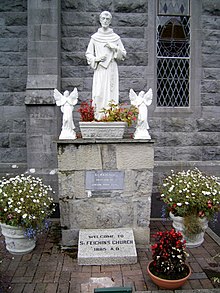Saint Fechin
|
Saint Féchín of Fore |
|
|---|---|
| Irish saint, monastic founder | |

Saint Féchín statue at Fore Abbey
|
|
| Personal details | |
| Born | Bile according to one source, but the saint was claimed by the Luigne, Gailenga and Fothairt |
| Died | 665 |
| Parents | Lassair (mother) |
| Sainthood | |
| Feast day | 20 January |
| Venerated in | Catholicism, Anglicanism |
| Patronage | Fore Abbey, Cong Abbey, Omey Island, Ardoilén, |
Saint Féchín or Féichín (died 665), also known as Mo-Ecca, was a 7th-century Irish saint, chiefly remembered as the founder of the monastery at Fore (Fobar), County Westmeath.
Sources for his life and legend include Irish annals, martyrologies, genealogies and hagiographical works. Of the two surviving medieval Lives, one was written in Latin, the other in Irish. The Latin Life was written c. 1400 by Augustine mac Graidín, who belonged to the All Saints' Island monastery in Lough Ree. His main source appears to have been a Life originating in Féchín's monastery on Omey Island. The Irish Life (Betha Féchín Fabair "The Life of St Féchín of Fore") was written down by Nicol Óg, son of the abbot of Cong, in 1328 and it seems that parts of it go back to even earlier (Latin) sources. The text may be seen as a combination of two texts. The first part is primarily concerned with the saint's position as a mediator and negotiator between the Luigne (or Luigni) of Connacht, of which he was supposedly a member, and the more powerful Luigne of Meath, on whose territory Fore Abbey was founded. The second part focuses more attention on Leinster and the payment of tribute. The Latin and Irish Lives both agree that Ailerán of Clonard, a contemporary of St Féchín, had composed an account of the saint's good works. In the 17th century, John Colgan produced another Latin Life (the Vita seu supplementum), for which he drew on three Irish Lives.
Féchín is said to have been born in Bile, probably Billa in what is now the parish of Ballysadare (Kilvarnet), (Co. Sligo). The medieval Lives call his mother Lassair, identified in the Irish text (first part) as a member of a royal Munster line. The late Irish Life asserts that the saint's foundation at Fore (Co. Westmeath) in Mide was connected to the Luigne and that Féchín himself belonged to the Luigne of Connacht. In the annal for 814, however, the Chronicon Scotorum appears to suggest that the saint's church was connected to both the Gailenga and the Luigne. On the other hand, the Life's claim is corroborated by an entry in the Annals of Ulster (sub anno 993) which styles Máel Finnia, bishop of Fore, bishop of the peoples (túatha) of the Luigne.
...
Wikipedia
